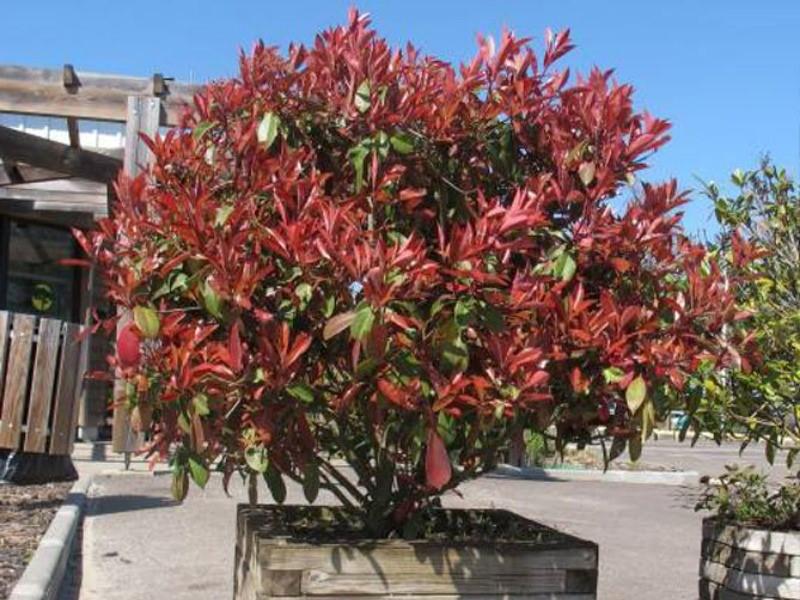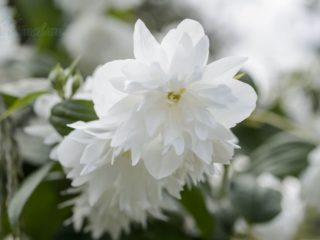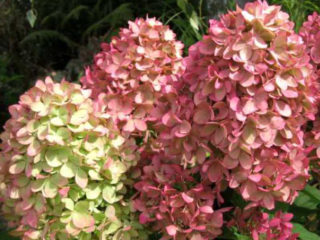Content
The photinia plant (lat. Photinia) belongs to the genus of the same name and is a representative of the Rosaceae family. The birthplace of the culture is considered to be South and East Asia, as well as North America. The plant is a shrub type and is highly decorative. Red-leaved photinia, as in the photo, is especially popular among gardeners. To achieve this shade, it is necessary to provide care taking into account the basic requirements of the culture.

The plant is characterized by increased endurance
Description of the photinia bush
The crop can be grown as a shrub or tree. Its height can reach 15 m, but in most cases does not exceed 5 m. The plant forms a lush, dense, uniform crown that holds its shape well in all weather conditions. Moreover, in shrubby crop species it goes down to the base.
The shoots are straight-growing and reddish in color. Some plant species have thorns on them.The leaves are leathery, shiny, oblong-elongated with a pointed tip. They are alternately located on the shoots. In some plant species, young plates when blooming have a rich reddish tint and retain it for a long time. As the leaves age, they turn dark green.
The root system of the plant is strong, well branched with a large number of absorbent shoots. But it is located superficially and is unable to extract moisture and nutrition from the deep layers of the soil.
The crop blooms annually, starting from the third year after planting. After pollination, spherical, apple-shaped fruits appear on the plant, the diameter of which is 4-5 cm. As they grow, they are red in color, but over time they turn black. Each fruit contains two to four seeds. The fruits stay on the branches for a long time and do not fall off. They are food for birds, which contributes to the spread of this culture.

Some species bear fruit only in the southern regions
How photinia blooms
Photinia flowers are white, of a typical shape, like all representatives of the Rosaceae family. They consist of splayed round petals and reach a diameter of 5-12 mm. When the buds are fully opened, in the center you can see a bunch of stamens, including 10-20 pieces.
The flowers of the plant are bisexual. They are collected in corymbose apical inflorescences. The flowering period begins in early summer and lasts 14-18 days.

When blooming, the flowers emit a hawthorn aroma
Frost resistance of the photinia plant
This culture belongs to the heat-loving category.The winter hardiness zone of photinia corresponds to at least -18 °C, and for some of its species the critical temperature is -12 °C. Therefore, it became widespread only in the southern regions. However, the photinia plant can also be grown in the Moscow region, the middle zone, but for this you need to provide good shelter for the winter, as well as planting in a place protected from cold gusts of wind.
In the northern regions of the country, photinia should be considered only as a container plant. In this case, during the cold period of the year it can be transferred to a warm room.
Types and varieties of photinia
The genus of culture includes about 40 types of culture. However, only two of them have become most widespread and have become the basis for obtaining new ornamental varieties. This is due to their unpretentiousness and high decorativeness.
Photinia Fraser
This is an evergreen shrub with a lush, dense crown. Its height does not exceed 4 m, and its diameter is 2-2.5 m. The leaves are ovoid with serrations, up to 9 cm long. The flowers are collected in corymbs with a diameter of about 12 cm.
Fraser's photinia (Photinia fraseri) can withstand frosts down to -12 °C. When blooming, the leaves of the species are bronze-red, and subsequently turn green.

Photinia Fraser blooms in late May or early June
Photinia serrata
This is an evergreen tree, the height of which reaches 12 m. However, since its trunk is often curved, the serrated photinia (Photinia serrulate) is most often grown as a shrub, which reaches 4 m.
When blooming, the young foliage of the plant is golden beige in color, but as it matures it turns green. The winter hardiness of this photinia is quite high.When placed correctly in a garden or on a site, it can withstand temperatures as low as -22 °C.

Photinia serrata is also called Chinese
Planting photinia
In order for the photinia shrub with red leaves to fully develop and remain viable for many years, it is necessary to plant it correctly. This can be done in early spring or autumn, but so that at least three weeks remain before the onset of permanent frosts.
Photinia can grow both in open sunny places and in partial shade. But the main thing is that it is protected from drafts. Therefore, it is better to plant near buildings or a fence at a distance of 3 m.
The plant does not make high demands on the soil. But the soil must be nutritious and loose, as well as neutral or slightly acidic. Two weeks before planting, it is necessary to prepare a hole measuring 60 by 60 cm. A layer of broken brick up to 10 cm thick should be laid at the bottom. It is recommended to fill the rest of the space with a soil mixture consisting of turf, peat, humus and leaf soil in equal proportions.
For planting, it is recommended to choose two- and three-year-old seedlings with a closed root system, which eliminates the possibility of their underground part drying out. Plants should have a healthy appearance and well-developed young shoots.
When planting, photinia should be placed in the center of the hole, but so that its root collar is 1.5 cm below the soil level. At the end of the procedure, water the plant generously. And the next day it is necessary to mulch the root circle with humus.
Photinia care
The full development of photinia depends not only on proper planting, but also on further care in the open ground. Young photinia seedlings need to be weeded regularly, removing weeds around them. Mature bushes and trees do not need this, since they independently suppress the development of unwanted vegetation.
Watering and fertilizing
After photinia takes root in a new place, it needs to be watered only during prolonged drought. To do this, you can use settled water at a temperature of +18-22 °C. Moisturizing is carried out in the evening at the root.
It is recommended to fertilize the crop twice per season. In early spring, nitroammophoska 30-100 g should be added to the root circle of the plant, and in summer superphosphate 60-120 g and potassium sulphide 30-80 g should be used.
Pruning photinia
Photinia needs periodic sanitary cleaning of the crown, starting from the third year after planting. When pruning, you need to remove broken and damaged shoots, as well as stems that are out of shape. The procedure can be done at any time of the growing season. It helps to increase the decorativeness of the plant, as it stimulates the growth of young leaves that have a red tint.

It is allowed to prune the plant three times during the season.
Wintering
At the end of September, it is necessary to water-recharge the plant in the absence of seasonal rains. At the end of October or early November, a layer of humus up to 10 cm thick should be laid in the root circle of the photinia. In addition, the crown of the bush or tree should be wrapped in several layers of agrofibre and fixed to the plant. In the spring, you need to remove the cover from the photina no earlier than the end of March.
How to propagate photinia
Photinia can be propagated by cuttings, layering, seeds and grafting. Each of these methods has its own characteristics.
When growing using seeds, it is important to have fresh planting material, as it quickly loses its viability. Planting should be done in late autumn under a thick layer of peat. This will allow the seeds to undergo natural stratification in winter. In the spring they germinate successfully. Seedlings grown from seeds can be transferred to a permanent place in the third year.
Photinia can also be rooted by layering. To do this, you need to bend the lower shoot of the bush in the spring, bury it 10 cm into the soil and secure it with a bracket, leaving only the top above the ground. Throughout the season, it is necessary to control soil moisture. If all recommendations are followed, the cuttings will take root by the end of summer. You can disconnect it from the mother plant in the third season.
Experienced gardeners can propagate photinia by grafting onto a standard. You can use chokeberry or hawthorn as a rootstock.
Cuttings of photinia
Rooting photinia by cuttings is the most affordable method of propagation if you need to obtain a lot of planting material at the same time. To do this, you can use green spring shoots of the plant or semi-lignified summer shoots. For cuttings, you need to use their upper part, 15-20 cm long. The lower part of the cuttings needs to be completely cleared of leaves.

It is recommended to shorten the plates at the top by half to maintain sap flow in the tissues
Cuttings should be planted in a soil mixture of peat and sand in equal quantities, deepened to 1/3 of the length. For their successful rooting, it is necessary to make a mini-greenhouse and ensure a maintenance regime of +20-22 °C. If all recommendations are followed, the cuttings begin to grow after 40-50 days.Young plants can be planted in a permanent place when they are strong enough.

The survival rate of cuttings is 60%
Diseases and pests of photinia
This plant is susceptible to fungal diseases. Most often, photinia suffers from powdery mildew and leaf spot. Therefore, when alarming signs appear, it is necessary to treat the plant with fungicides such as Skor, Topaz, Hom. It is also recommended to preventively spray the bushes in spring and autumn with Bordeaux mixture.
Among the pests, mites can cause damage to the crop. In this case, the plant looks dejected, its development slows down, and it weakens. It is recommended to use Actellik and Fufanon for pest control.
How fast does photinia grow?
The lifespan of a culture in one place is more than 25 years. The annual growth of the plant is 40 cm. However, in the first season after planting, the plant needs an adaptation period. Therefore, its active development begins in the second year.
Photos of photinia in landscape design
Photinia looks great in the garden as a tapeworm, as well as in group plantings. In any case, this plant does not go unnoticed on the site. It is recommended to consider options for using culture in landscape design.

The shrub goes well with jasmine, forsythia, mock orange

The shrub is great for a hedge

By pruning the crown can be given different shapes

This plant looks impressive even in a pot.

Growing a plant on a trunk allows you to create unique compositions on the site
Conclusion
The photinia plant is distinguished by its originality. After all, you can see red and green leaves on it at the same time if you carry out periodic pruning.This gives the plant a special decorative effect. However, you need to care for the crop correctly. Only in this case the plant forms a lush, dense crown.
Reviews about growing photinia








